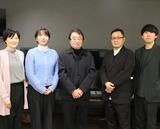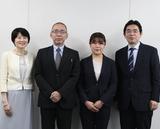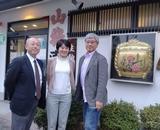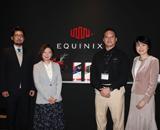March 2020
Working with International Human Resources: Advice from a Leading Intercultural Management Facilitator
From business persons to regular citizens, almost everyone in Japan is communicating more often with people from outside the country--be it as a hobby or out of professional necessity. However, as such opportunities increase, so do communication issues. The cause of these issues often has less to do with language and more to do with a lack of cultural understanding. How then can we change the way we communicate depending on the other person's culture? The answer lies in the 6-D model of national culture created by Professor Geert Hofstede, a world-renowned expert on cultural diversity and organizational culture.
Ms. Chikako Miyamori currently works in the field of intercultural management and is one of the few facilitators certified by Professor Hofstede as an expert of the Hofstede model. In spring 2019, she published a book titled Intercultural Compatibility as a Management Strategy: Practical Application of the Hofstede 6-D Model* (in Japanese only).
We sat down with Ms. Miyamori to ask how she discovered the Hofstede model and how we can apply it in our line of work.
*Miyamori, Chikako and Miyabayashi, Ryukichi. Keiei senryaku toshite no ibunka tekiōryoku: Hofstede no roku jigen model jissenteki katsuyōhō (Intercultural Compatibility as a Management Strategy: Practical Application of the Hofstede 6-D Model). JMA Management Center Inc., 2019.
Chikako Miyamori
- Profile
- Chikako Miyamori: Professor Hofstede-certified facilitator and master trainer
- Mariko Ohsato: CEO & President, Arc Communications Inc.
I Couldn't Understand what People from Different Cultures Were Thinking
Ohsato: As foreign human resources are becoming increasingly more important in today's labor market, what I wanted to ask you most was how you discovered the Hofstede model. What made you, a public relations professional, become a facilitator of the Hofstede model and where does your passion for the model come from?
Miyamori: After earning my MBA at a business school in the UK, I worked at an American company's UK office for a while, where I was ingrained with the Anglo-Saxon way of doing business. In my second year at the company, I was put in charge of e-mail marketing projects for Southeast Asia and Eastern Europe, so I began frequently traveling to those regions and meeting people who, like me, worked for American companies. What stumped me though, was that the Anglo-Saxon approach, which I had grown so familiar with, didn't get through to them. It fell flat. I had no idea what was going on and it left me feeling very troubled. I eventually returned to Japan, but I couldn't shake that feeling of perplexity.
Ohsato: That does sound troubling. What sort of work did you do in Japan?
Miyamori: I joined the public relations department at the company's office in Japan, and my plan was to implement the Anglo-Saxon style of numerical management. I wanted to put into place a system that would dictate how often we publish our company's information in different mediums and the number of points that would be earned by selecting certain themes. But when I suggested that, all I got were blank stares. At the time, many different business departments were sending out press releases every day, so I also suggested we cut back on the numbers and focus on efficiently providing information--and that got shot down almost immediately too (laughs).
Ohsato: That must have been very upsetting.
Miyamori: It was, yes. At the time, I couldn't understand why they didn't like this approach. I thought maybe they didn't like the numerical evaluation system since public relations is often seen as a cost center. Or maybe it was some other reason--I had no idea. I believed I was doing the right thing, but the people around me didn't think it was right. While that dilemma was still heavy on my mind, my husband got assigned to Barcelona, Spain, and I moved with him. It was there that I discovered Professor Hofstede's 6-D model.
Ohsato: So now we're getting to the part that led to your current work. How did the Hofstede model influence you?
Miyamori: Since I had worked in public relations for a foreign company, I understood the importance of organizational culture, but the Hofstede model made me realize I had to study national cultures as well. In fact, once I started studying the cultures of different countries, I began to see how I could have approached matters differently to resolve the issues I once faced. I kept thinking, "if only I had known this before, I wouldn't have made so many mistakes." From now, more average Japanese people like me are going to start living outside of Japan and more international people are going to come to Japan as well. As I learned more about the Hofstede model, I began to strongly believe that we should use this sort of approach as a tool to improve intercultural communication.
Understanding Cultures Logically with the Hofstede Model
Ohsato: Could you briefly explain the Hofstede model?
Miyamori: Its official name is the 6-D model of national culture. It identifies six dimensions of relative cultural differences between countries worldwide and scores them on a scale of 0 to 100. These dimensions are the six universal issues faced by human society that Professor Hofstede focused on. By expressing their intensity in numerical values, the model allows anyone to objectively understand cultural differences.
1. Power distance (high vs low): relationship with power
2. Individualism vs collectivism: relationship between individuals and groups
3. Masculinity vs femininity (achievement vs quality of life): difference of roles expected of men and women; motivational factors
4. Uncertainty avoidance (high vs low): handling uncertainty and ambiguity
5. Long- vs. short-term orientation: thinking about the future
6. Indulgence vs restraint: life enjoyment
The Hofstede model began with an awareness survey taken by 116,000 employees of the American company IBM in over 50 countries. When Professor Hofstede analyzed the results and compared how awareness and actions differed among the employees, he noticed that issues mainly stemmed from cultural differences rather than occupation, gender or age. Professor Hofstede later conducted a subsequent survey using the same questions at the Swiss company IMEDE (currently IMD) and then spent the next several years creating this model. In the Wall Street Journal published on May 5, 2008, he was named one of the 20 most influential business thinkers alongside Professor Ikujiro Nonaka, Professor Henry Mintzberg and Dr. Peter Senge.
Professor Hofstede holds PhDs in mechanical engineering and social psychology and has taught organizational anthropology and international management at Maastricht University. At 90 years old, he still conducts research diligently with a broad, birds-eye-view perspective, and his admirable academic stance never fails to impress me.
Ohsato: So the Hofstede model fit perfectly with your thinking back then.
Miyamori: Yes. The thing is, it's easy to talk about your own experiences with different cultures, but as I was slowly realizing, it's not something we can just talk about offhand. So I wanted an academic basis and Professor Hofstede's theory, backed by research, was exactly what I was looking for. Even so, Professor Hofstede always says that the model can't solve everything, and this sort of humble scholar's attitude is another reason why I respect him so much.
Ohsato: When you explain the Hofstede model, what are you focusing on so that more people can use it effectively and spread it throughout Japan?
Miyamori: I feel like a lot of people get a grasp of what I'm trying to explain when I say, "Can you compare Japanese culture and explain it relatively to the culture of other countries? With the Hofstede model we can to do this from an objective viewpoint."
When we look at the six dimensions, the scores for "power distance" and "individualism vs collectivism" in Japan ranks near the middle of the world. But when I ask Japanese people whether they think Japan is a collectivist country, almost 99% of them answer yes. So it's not quite as they think. Meanwhile, the "masculinity vs femininity" dimension shows an extremely high masculinity score (motivated by achievements, success and social standing in a competitive society) as well as a high uncertainty avoidance score, which indicates that Japanese people fear uncertainty, ambiguity and the unknown. There is no other country like this in the world. When I start conversations with this analysis, it surprises people and seems to draw their interest.
Ohsato: I feel like there's a risk of creating stereotypes by categorizing behavior by country. Even though the Hofstede model is based on academic research, there are obviously individual differences between people. So what is the best way for us to interpret and work with this model?
Miyamori: We can use the Hofstede model and combine its various dimensions to think about why something happens the way it does when we interact with people from different cultures. We can even dig deeper and consider whether this stems from national culture, organizational culture or individual behavior. Being able to pick up on these clues can lead to finding solutions to problems we may run into. The model can also be applied outside of business. When watching the daily news, for example, we can clearly see the substance of various issues by thinking about them through the perspective of the model.
Feature Interview Index
















